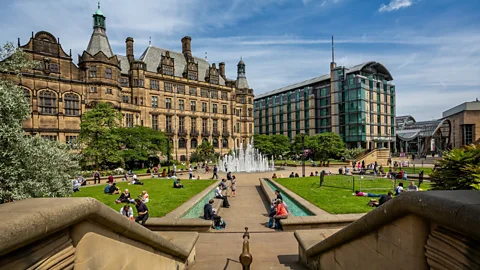ADS
It’s now the UK’s greenest city.
In Sheffield’s Kelham Island Museum’s lofty vaulted warehouse, the sun shone in and the 425-ton, 12,000-horsepower River Don Engine, meant to roll armour plating, started up. Small puffs of steam belied its tremendous strength. I joined a crowd to witness Europe’s most powerful functioning steam engine as a reminder of this city’s industrial past.
Sheffield is a hilly city with seven mild peaks around the city center in a valley. Five water sources—the River Don and its four tributaries, the Sheaf, Rivelin, Loxley, and Porter Brook—contributed to its development.
From the 12th century, fast-flowing water drove waterwheels that powered hundreds of mills, and Sheffield became the cradle of cutlery and knife blades. The later Industrial Revolution’s technological and scale advances cemented Sheffield’s status as the world’s premier steel manufacturer, earning it the nickname “The Steel City”.
This former industrial powerhouse today boasts the greenest city center in Britain, with 61% of its catchment area covered in parks, forests, and gardens, including one-third of the Peak District National Park’s exposed moors and scrubby heathland. Although access to the countryside isn’t new, Sheffield’s reputation as a green city has increased.
GREEN SHADE
Sheffield’s greenness goes beyond parks and trees. Sheffield was named the UK’s most eco-friendly city in the 2021 Green Cities Report by NatWest and The University of Southampton, based on green energy generation and its aim of achieving a net-zero carbon metropolis by 2050.
Many local people were angry when municipal contractors down several good trees to make place for new seedlings in 2012, marking a major change. Sheffield’s tree disaster lasted years until local groups and the municipality reached a compromise in December 2018. In 2019, the innovative Sheffield Street Trees Partnership (SSTP) was born from sapling stumps.
“There has been a lot written about the felling of Sheffield’s street trees,” stated SSTP Chair Nathan Edwards. Some argue the conflict has transformed the city’s narrative, linking residents to their green areas. Green space has long been important to Sheffielders. The street tree-felling event reactivated something that may have always been there.”
Sheffield has the most trees per person in Europe, with 4.5 million trees compared to 550,000 people. Edwards said, “This means around seven trees per household with 18.4% tree cover. Almost 20% of the city is covered with trees.”
Sheffield was named one of the World’s Tree Cities in 2022 by the organization that honors councils that actively maintain their urban woodlands.
The massive Tube-style Greenground Map celebrates all 800 of Sheffield’s green spaces by highlighting the many trails and walking opportunities alongside existing routes like the 15-mile Sheffield Round Walk and the eight-mile Blue Loop.
Visitation instructions
Consider staying at the historic Leopold Sheffield, which utilizes 100% green energy and prioritizes local goods.
Eat at award-winning True Loves and Rafters for locally sourced food in trendy settings.
To explore, stroll through parks, visit the Botanical Gardens, visit Graves Gallery for art, Kelham Island Museum for history, and enjoy local beers at The Fat Cat, the city’s first genuine ale bar.
Traveling about Sheffield is simple because to its efficient and dependable bus and tram network.
Plan your visit during the Sheffield Walking Festival in mid-September to explore parks and open areas on expert-led guided walks. Several Heritage Open Day activities are free.
“I can honestly say it’s the coolest city I’ve worked with,” said 2021 Greenground Map creator Helen Ilus, an Estonian graphic artist. “I don’t know any other UK city with so much open space and opportunities to go out and get active.”
I took pieces from the Sheffield Round Walk to extend into the city center, hoping to unearth history and green ideas.
My morning started with a steady, puff-inducing ascent the River Don Engine would have loved into lush Whiteley Woods, then a zigzag down the slope to a pathway down Porter Brook, pausing at the Shepherd Wheel Workshop.
This late-16th-century waterwheel powered blade-sharpening grinding stones. It filled and turned, showing how closely Sheffield’s natural resources are tied to its industrial history with weirs, dams, and man-made channels along the rivers.
I then followed the long, winding path through family-favorite Endcliffe Park, with its duck ponds, stepping stones, and sports fields, to the immaculate Sheffield Botanical Gardens, a Grade-II-listed site with period pavilions, Victorian flowerbeds, Mediterranean and wild rock gardens, and a rare 19th-century bear pit.
The gardens’ education officer, Dr. Laura Alston, stated, “It’s great to go around so many green places in the city. Sheffielders are fortunate.”
I headed north to Weston Park, the city’s first municipal park, inaugurated in 1873. When Sheffield was full with manufacturers, this groundbreaking park—an early governmental recognition of the need for green space—would have offered wealthy citizens clean air and refuge.
Thankfully, the value of nature for physical and mental health is now a given, as seen in West Bar’s ingenious “Grey to Green” rewilding and drainage project. A once-derelict road is now a biodiverse corridor with flowers, sculptures, seats, insect hotels, and information signs. The plants are picked to enhance air quality and attract animals, and the dirt is recycled.
This regenerative success story has revitalized this city neighborhood. Bees swarmed in and out of their man-made sanctuaries, flowers waved in the wind, and the River Don flowed calmly.
I walked past parks and green areas to Norfolk Heritage Park’s lengthy tree-lined road, which Alston recommended for its “incredible history and views”. This 28-hectare Victorian communal area offers space to play, stroll, and escape the city’s crowded streets. Looking north with an arc of woods behind me, I marveled at how the undulating green park poured into the valley-dwelling metropolis. I felt shockingly remote from the Saturday afternoon activity below as I took in this vast greenery.
Sheffield is the greenest city in the UK and second in Europe after Oslo, with 72% green areas.
Mark Mobbs, Sheffield City Council’s city campaigns manager, says, “It’s about how those green spaces connect different parts of the city and are usable as part of daily life, not just whether they are enormous areas that may not be that usable.”
said, “I really feel that [Sheffield] has unique accessibility to genuine green space, not just small patches of grass, right from the city centre and throughout the suburbs.”
Maybe that’s the goal. Mobbs believes Sheffield is “where nature and culture go hand in hand… our green spaces [are] part of our city identity.” Maybe it will keep this once-heavy industrial metropolis evolving responsibly for years.





